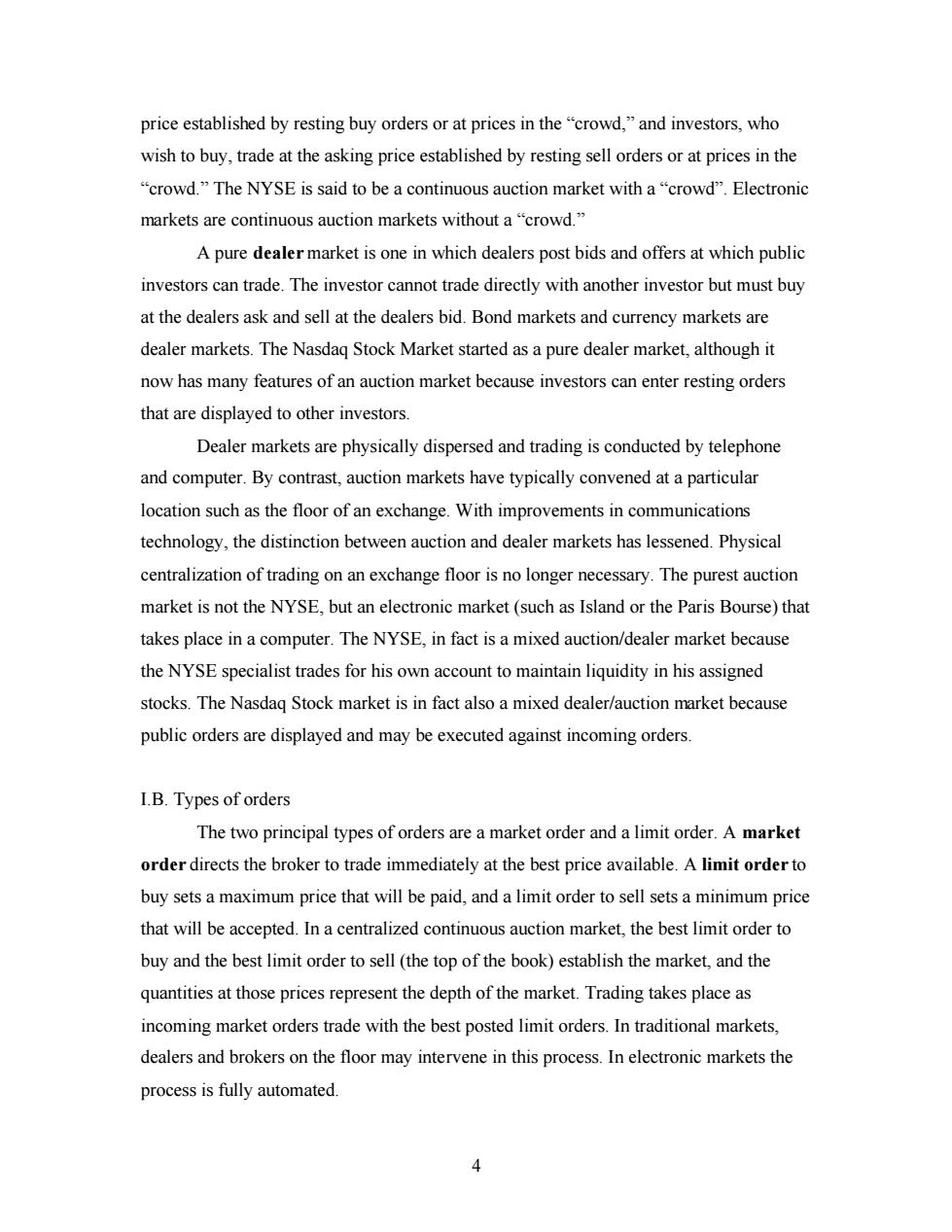正在加载图片...

price established by resting buy orders or at prices in the "crowd,"and investors,who wish to buy,trade at the asking price established by resting sell orders or at prices in the "crowd."The NYSE is said to be a continuous auction market with a"crowd".Electronic markets are continuous auction markets without a"crowd." A pure dealer market is one in which dealers post bids and offers at which public investors can trade.The investor cannot trade directly with another investor but must buy at the dealers ask and sell at the dealers bid.Bond markets and currency markets are dealer markets.The Nasdaq Stock Market started as a pure dealer market,although it now has many features of an auction market because investors can enter resting orders that are displayed to other investors. Dealer markets are physically dispersed and trading is conducted by telephone and computer.By contrast,auction markets have typically convened at a particular location such as the floor of an exchange.With improvements in communications technology,the distinction between auction and dealer markets has lessened.Physical centralization of trading on an exchange floor is no longer necessary.The purest auction market is not the NYSE,but an electronic market(such as Island or the Paris Bourse)that takes place in a computer.The NYSE,in fact is a mixed auction/dealer market because the NYSE specialist trades for his own account to maintain liquidity in his assigned stocks.The Nasdaq Stock market is in fact also a mixed dealer/auction market because public orders are displayed and may be executed against incoming orders. I.B.Types of orders The two principal types of orders are a market order and a limit order.A market order directs the broker to trade immediately at the best price available.A limit order to buy sets a maximum price that will be paid,and a limit order to sell sets a minimum price that will be accepted.In a centralized continuous auction market,the best limit order to buy and the best limit order to sell(the top of the book)establish the market,and the quantities at those prices represent the depth of the market.Trading takes place as incoming market orders trade with the best posted limit orders.In traditional markets, dealers and brokers on the floor may intervene in this process.In electronic markets the process is fully automated.4 price established by resting buy orders or at prices in the “crowd,” and investors, who wish to buy, trade at the asking price established by resting sell orders or at prices in the “crowd.” The NYSE is said to be a continuous auction market with a “crowd”. Electronic markets are continuous auction markets without a “crowd.” A pure dealer market is one in which dealers post bids and offers at which public investors can trade. The investor cannot trade directly with another investor but must buy at the dealers ask and sell at the dealers bid. Bond markets and currency markets are dealer markets. The Nasdaq Stock Market started as a pure dealer market, although it now has many features of an auction market because investors can enter resting orders that are displayed to other investors. Dealer markets are physically dispersed and trading is conducted by telephone and computer. By contrast, auction markets have typically convened at a particular location such as the floor of an exchange. With improvements in communications technology, the distinction between auction and dealer markets has lessened. Physical centralization of trading on an exchange floor is no longer necessary. The purest auction market is not the NYSE, but an electronic market (such as Island or the Paris Bourse) that takes place in a computer. The NYSE, in fact is a mixed auction/dealer market because the NYSE specialist trades for his own account to maintain liquidity in his assigned stocks. The Nasdaq Stock market is in fact also a mixed dealer/auction market because public orders are displayed and may be executed against incoming orders. I.B. Types of orders The two principal types of orders are a market order and a limit order. A market order directs the broker to trade immediately at the best price available. A limit order to buy sets a maximum price that will be paid, and a limit order to sell sets a minimum price that will be accepted. In a centralized continuous auction market, the best limit order to buy and the best limit order to sell (the top of the book) establish the market, and the quantities at those prices represent the depth of the market. Trading takes place as incoming market orders trade with the best posted limit orders. In traditional markets, dealers and brokers on the floor may intervene in this process. In electronic markets the process is fully automated